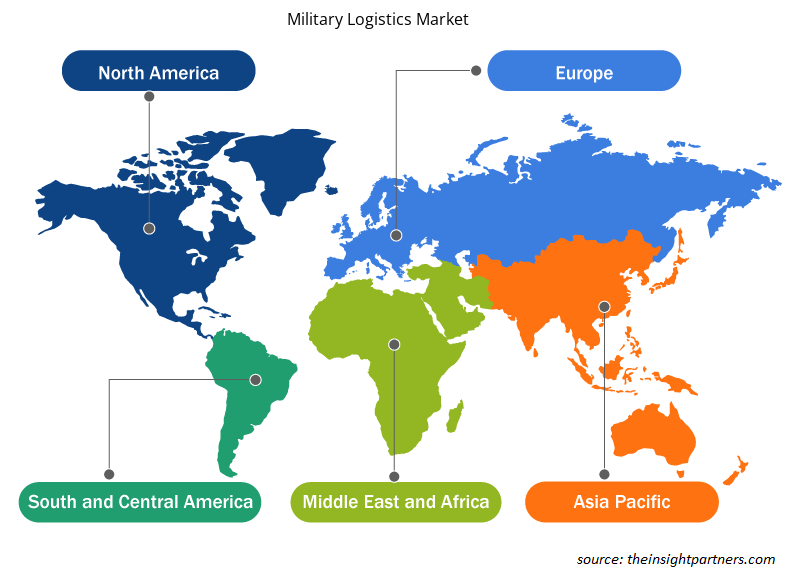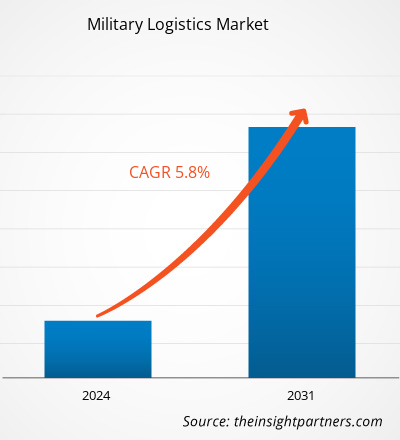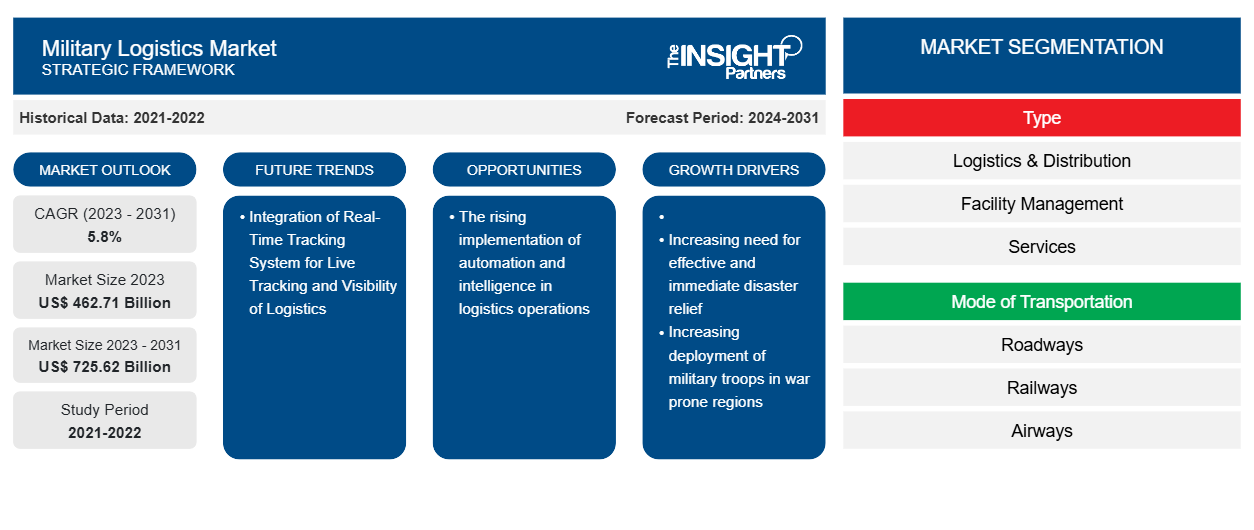Si prevede che la dimensione del mercato della logistica militare raggiungerà i 725,62 miliardi di dollari entro il 2031, rispetto ai 462,71 miliardi di dollari del 2023. Si prevede che il mercato registrerà un CAGR del 5,8% nel periodo 2023-2031. È probabile che la crescente implementazione dell'automazione e dell'intelligenza nelle operazioni logistiche rimanga una tendenza chiave nel mercato.
Analisi del mercato della logistica militare
Gli acquirenti continuano a godere di un elevato potere contrattuale nel mercato grazie a forze incentrate sul cliente come la presenza di un gran numero di operatori di mercato, politiche favorevoli, regolamenti, linee guida e un potere d'acquisto significativamente elevato delle forze militari. Inoltre, la natura sensibile dei componenti militari, dei sistemi e di altri asset critici dovuta alla loro autorizzazione di sicurezza e alla natura riservata ha portato a un numero significativamente elevato di politiche logistiche, regolamenti e linee guida per gli operatori di mercato. Pertanto, il potere contrattuale complessivo degli acquirenti è elevato e si prevede che rimarrà elevato nei prossimi anni.
Panoramica del mercato della logistica militare
Attualmente, il mercato della logistica militare è composto da grandi e affermati operatori di mercato con una consistente base di clienti. Inoltre, le grandi barriere all'ingresso insieme all'inclinazione del governo a premiare il precedente impegno aziendale di lunga data hanno anche contribuito alla bassa minaccia da parte di nuovi entranti nel mercato della logistica militare. Tuttavia, i recenti tagli al bilancio e l'aumento della domanda di pianificazione, gestione e funzionamento della logistica superiore dovrebbero allentare le barriere per l'offerta logistica selezionata. Ad esempio, si prevede che le opportunità per servizi logistici migliorati come consulenza, ottimizzazione e integrazione e supporto di tecnologie avanzate insieme al suo supporto logistico forniranno moderate barriere all'ingresso nei prossimi anni.
Personalizza questo report in base alle tue esigenze
Riceverai la personalizzazione gratuita di qualsiasi report, comprese parti di questo report, o analisi a livello nazionale, pacchetto dati Excel, oltre a usufruire di grandi offerte e sconti per start-up e università
-
Scopri le principali tendenze di mercato in questo rapporto.Questo campione GRATUITO includerà analisi di dati che spaziano dalle tendenze di mercato alle stime e alle previsioni.
Driver e opportunità del mercato della logistica militare
Crescente necessità di soccorsi efficaci e immediati in caso di calamità
L'esercito svolge un ruolo fondamentale nel supportare gli sforzi di soccorso umanitario. Il crescente coinvolgimento dell'esercito nei soccorsi in caso di calamità sta guidando la domanda di servizi logistici militari efficaci. L'esercito fornisce servizi quali risorse materiali per progetti infrastrutturali, supporto logistico , sicurezza per i soccorritori e altri. Il fornitore di servizi logistici militari deve essere rapido ed efficace nel trasportare le risorse necessarie nel luogo soggetto a calamità. Con il crescente coinvolgimento dell'esercito e la domanda di servizi rapidi nei siti di calamità, si prevede che il mercato della logistica militare assisterà a una crescita significativa durante il periodo di previsione.
Integrazione del sistema di tracciamento in tempo reale per il monitoraggio in tempo reale e la visibilità della logistica
I fornitori di logistica militare stanno integrando soluzioni intelligenti per il monitoraggio e la visibilità in tempo reale delle merci. Il sistema di monitoraggio in tempo reale include GIS, RFID e altre soluzioni. La logistica militare deve coordinare il movimento di più veicoli militari, attrezzature, merci e altro. Con l'integrazione della tecnologia GIS, genera mappe dettagliate per identificare percorsi ottimali, condizioni stradali e meteorologiche e altre informazioni. Traccia anche i veicoli in tempo reale con il contenuto esatto della spedizione. Fornisce anche capacità di risposta alle emergenze. Per garantire il movimento sicuro e protetto delle merci, i fornitori sono altamente concentrati sull'implementazione di queste tecnologie. Si prevede che la domanda di sistemi di monitoraggio in tempo reale e altre soluzioni di sicurezza avanzate aumenterà durante il periodo di previsione insieme ad altri servizi logistici e rappresenterà un'enorme opportunità per i fornitori che operano nel mercato della logistica militare.
Analisi della segmentazione del rapporto di mercato sulla logistica militare
I segmenti chiave che hanno contribuito alla derivazione dell'analisi di mercato della logistica militare sono il tipo e la modalità di trasporto.
- In base al tipo, il mercato della logistica militare è segmentato in logistica e distribuzione, facility management e servizi. Il segmento della logistica e distribuzione ha detenuto una quota di mercato maggiore nel 2023.
- In base alla modalità di trasporto, il mercato della logistica militare è segmentato in strade, ferrovie, vie aeree e vie d'acqua. Il segmento delle strade deteneva una quota di mercato maggiore nel 2023.
Analisi della quota di mercato della logistica militare per area geografica
L'ambito geografico del rapporto sul mercato della logistica militare è suddiviso principalmente in cinque regioni: Nord America, Europa, Asia Pacifico, Medio Oriente e Africa e Sud America.
L'Asia Pacifico ha dominato il mercato nel 2023, seguita dalle regioni di Europa e Nord America. Inoltre, è probabile che anche l'Asia Pacifico assista al CAGR più elevato nei prossimi anni. La Cina ha dominato il mercato della logistica militare dell'Asia Pacifico nel 2023. Inoltre, la guerra in corso nelle regioni di Europa e Medio Oriente ha avuto un impatto anche sulla domanda di logistica militare in tali regioni. La guerra tra Russia-Ucraina, Israele-Palestina e il coinvolgimento di altri paesi in tali guerre sta spingendo la domanda di logistica militare poiché ci sono molte truppe dispiegate in più sedi in Europa e nei paesi del Medio Oriente. Tali fattori hanno guidato la crescita del mercato della logistica militare in diverse regioni.
Approfondimenti regionali sul mercato della logistica militare
Le tendenze regionali e i fattori che influenzano il Military Logistics Market durante il periodo di previsione sono stati ampiamente spiegati dagli analisti di Insight Partners. Questa sezione discute anche i segmenti e la geografia del Military Logistics Market in Nord America, Europa, Asia Pacifico, Medio Oriente e Africa e Sud e Centro America.

- Ottieni i dati specifici regionali per il mercato della logistica militare
Ambito del rapporto sul mercato della logistica militare
| Attributo del report | Dettagli |
|---|---|
| Dimensioni del mercato nel 2023 | 462,71 miliardi di dollari USA |
| Dimensioni del mercato entro il 2031 | 725,62 miliardi di dollari USA |
| CAGR globale (2023-2031) | 5,8% |
| Dati storici | 2021-2022 |
| Periodo di previsione | 2024-2031 |
| Segmenti coperti |
Per tipo
|
| Regioni e Paesi coperti |
America del Nord
|
| Leader di mercato e profili aziendali chiave |
|
Densità degli attori del mercato della logistica militare: comprendere il suo impatto sulle dinamiche aziendali
Il mercato della logistica militare sta crescendo rapidamente, spinto dalla crescente domanda degli utenti finali dovuta a fattori quali l'evoluzione delle preferenze dei consumatori, i progressi tecnologici e una maggiore consapevolezza dei vantaggi del prodotto. Con l'aumento della domanda, le aziende stanno ampliando le loro offerte, innovando per soddisfare le esigenze dei consumatori e capitalizzando sulle tendenze emergenti, il che alimenta ulteriormente la crescita del mercato.
La densità degli operatori di mercato si riferisce alla distribuzione di aziende o società che operano in un particolare mercato o settore. Indica quanti concorrenti (operatori di mercato) sono presenti in un dato spazio di mercato in relazione alle sue dimensioni o al valore di mercato totale.
Le principali aziende che operano nel mercato della logistica militare sono:
- AECOM
- ANHAM FZCO
- Aselsan AS
- Sistemi BAE PLC
- Società internazionale DynCorp LLC
Disclaimer : le aziende elencate sopra non sono classificate secondo un ordine particolare.

- Ottieni una panoramica dei principali attori del mercato della logistica militare
Notizie e sviluppi recenti del mercato della logistica militare
Il mercato della logistica militare viene valutato raccogliendo dati qualitativi e quantitativi dopo la ricerca primaria e secondaria, che include importanti pubblicazioni aziendali, dati associativi e database. Di seguito sono elencati alcuni degli sviluppi nel mercato della logistica militare:
- Il Ministero della Difesa ha annunciato oggi che intende firmare un contratto di programma logistico di 13 anni con Leidos, in seguito al successo delle trattative. (Fonte: Leidos, comunicato stampa, marzo 2015)
- Un sistema logistico fondamentale per le operazioni delle Forze armate britanniche in tutto il mondo sarà supportato da un nuovo contratto quinquennale da 460 milioni di sterline con Boeing Defence UK. (Fonte: UK MOD, comunicato stampa, gennaio 2021)
Copertura e risultati del rapporto sul mercato della logistica militare
Il rapporto "Dimensioni e previsioni del mercato della logistica militare (2021-2031)" fornisce un'analisi dettagliata del mercato che copre le seguenti aree:
- Dimensioni e previsioni del mercato della logistica militare a livello globale, regionale e nazionale per tutti i segmenti di mercato chiave coperti dall'ambito
- Tendenze del mercato della logistica militare e dinamiche di mercato come fattori trainanti, vincoli e opportunità chiave
- Analisi dettagliata delle cinque forze di Porter
- Analisi di mercato del mercato della logistica militare che copre le principali tendenze del mercato, il quadro globale e regionale, i principali attori, le normative e i recenti sviluppi del mercato
- Analisi del panorama industriale e della concorrenza che copre la concentrazione del mercato, l'analisi della mappa di calore, i principali attori e gli sviluppi recenti per il mercato della logistica militare
- Profili aziendali dettagliati
- Analisi storica (2 anni), anno base, previsione (7 anni) con CAGR
- Analisi PEST e SWOT
- Valore/volume delle dimensioni del mercato - Globale, Regionale, Nazionale
- Industria e panorama competitivo
- Set di dati Excel
Report recenti
Rapporti correlati
Testimonianze
Motivo dell'acquisto
- Processo decisionale informato
- Comprensione delle dinamiche di mercato
- Analisi competitiva
- Analisi dei clienti
- Previsioni di mercato
- Mitigazione del rischio
- Pianificazione strategica
- Giustificazione degli investimenti
- Identificazione dei mercati emergenti
- Miglioramento delle strategie di marketing
- Aumento dell'efficienza operativa
- Allineamento alle tendenze normative























 Ottieni un campione gratuito per - Mercato della logistica militare
Ottieni un campione gratuito per - Mercato della logistica militare